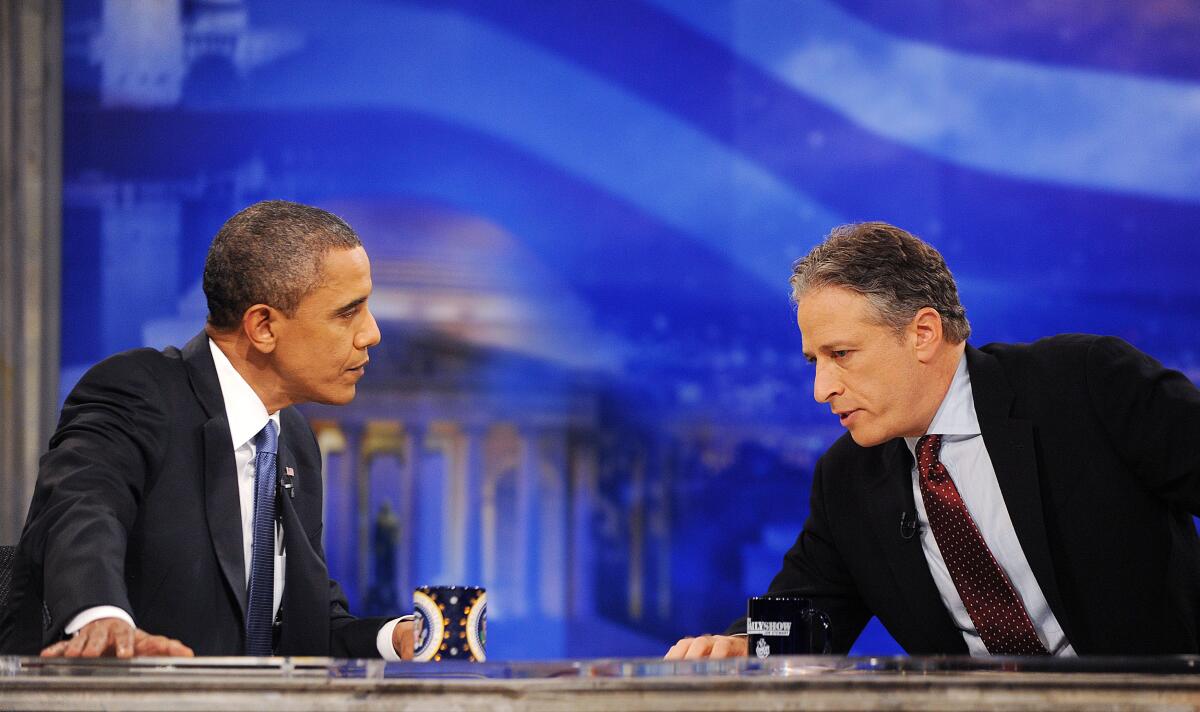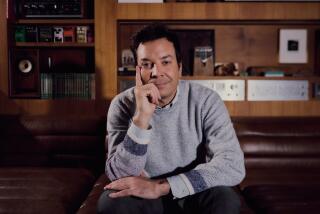Late night evolves slowly, as seen by ‘After Midnight’ and Jon Stewart’s ‘Daily Show’ return

Change comes slowly to late night television. Talk show hosts occupy their seats for years and years and, on the whole, leave only when they’re ready.
Having spent nearly a year and a half not deciding on a replacement for Trevor Noah, its host since 2015, “The Daily Show” has turned again to Jon Stewart. Stewart, 61, who presided over the show for 16 years, will become the program’s regular Monday night host this week, and also an executive producer. (Guest hosts and “Daily Show” “correspondents” will fill out the rest of the week.) His “this can’t be happening” affect may be just what this absurd year needs — he’s expected to stay through the presidential election — but it remains to be seen whether this step backward is a step forward, or a step forward that’s just a step back.
On “The Daily Show” podcast, Jon Stewart says his decision to return wasn’t just about the election, and he felt “you have to be present in this conversation.” Listen to the episode exclusively here.
Meanwhile, over on CBS — the broadcast network big time — where James Corden left “The Late Late Show” after eight years, talented young comic Taylor Tomlinson, 30, has been anointed his successor, at least in terms of taking over the time slot. This struck me as good news when I heard it, both for her youth — the torch being passed to a new generation and all — and her sex: You can count the number of women who have hosted network late night shows on the fingers of one hand. (Cable and streaming platforms have seen female hosts as well, but only Chelsea Handler’s “Chelsea Lately” and Samantha Bee’s “Full Frontal” have had any kind of life.) I was excited to see what she’d do with the medium.

Imagine my disappointment, then, when “After Midnight” proved to be not a talk show — and by “talk show” I mean anything from a show that’s all talk to one that’s closer to variety, with sketches and musical numbers and whatnot — but a revival of an old Comedy Central panel show, “@midnight.” (The confusion was all mine — it was not a secret.) I remember that show, which ran from 2013- 17 and consisted of guest comedians riffing on internet videos and memes, as amusing and energetic. (Though mostly I remember host Chris Hardwick crying “Points!” as he arbitrarily assigned them to its contestant guests.)
And so I’ve got nothing against “After Midnight,” per se, which capably fulfills its brief, gives work to comedians I like and for all I know hits a bulls eye on its target market. It might run until there is no more internet to mock. (Stephen Colbert produces the show; the idea to bring back “@midnight” obviously preceded Tomlinson’s choice as host.)
Still, it strikes me as a missed opportunity, a tightly formatted, conservative choice for a sector of television that has been historically open to, even relied on innovation; sillier and more serious than prime time, it’s a place for Masturbating Bears and Closer Looks, for toy instruments and in-depth discussions, robot co-hosts and personal revelations, among many other things you would never find in prime time. Political satire, which to greater and lesser degrees is an aspect of most late night shows, doesn’t exist before 11 p.m.; Stewart’s “Daily Show” could have happened only after prime time.
The comedian prepares to unveil her third Netflix special Tuesday on the heels of the premiere of her new late-night TV gig ‘After Midnight’ on CBS.
New late night hosts have typically arrived with their own creative team and after a period of adjustment — during which they may receive skeptical, often negative notices from viewers and reviewers — establish an identity, a rhythm, bring dumb ideas to productive life and discover the bits and characters that keep an audience coming back. Conan O’Brien, an unknown quantity when he took over “Late Night” in 1993, and something of a weirdo, barely survived cancellation in his first year, but ultimately hung around for 16 seasons. His weirdness won out.
The world has changed, of course, around these shows, which date back to the dawn of the medium. (“The Tonight Show” turns 70 this year.) Until the adoption of the VCR, late night television was available only at night; it had what might be called a circadian subtext. Where consumers now shape television to their schedule, television once shaped the day. Late night TV was for people who were happy to forgo sleep, or couldn’t sleep, or had nowhere they had to be in the morning. You might not be ready for bed after Johnny Carson finished, or you’d come in from a club or a movie or whatever and turn on the set, and there’d be Tom Snyder talking to John Lydon or Orson Welles, or Chris Elliott living under the bleachers on “Late Night With David Letterman.” The later the start time, the less the financial risk and so the more freedom to play — and arguably the more dedicated the fanship. Craig Ferguson’s still-celebrated throw-out-the-cards, unusually autobiographical “Late Late Show,” was constitutionally a 12:30 a.m. show; it wouldn’t have worked at 11:30. And the people remember.

Bowing down to the new clip economy, the broadcast networks have all made their deals with that devil, creating their own streaming platforms: You can get CBS through Paramount+ and NBC via Peacock and ABC and Fox shows from Hulu, and watch them whenever and wherever you want; for such users, “late night” is an aesthetic rather than a chronological term. And every late night show has a presence on YouTube, where the previous night’s program will appear cut into digestible pieces the morning after.
I’ll admit to getting my late night television this way, sometimes much after the fact — though there was a time I was down in the real-time trenches, watching until the end of “the broadcast day” when the picture turned to snow. And I probably watched the snow for a while.
As a show on CBS, “After Midnight” comes with a certain prestige; Tomlinson’s stewardship would not be such big news were it being shown on Comedy Central. It is in that limited sense important, and I certainly wish her success. (Though she is already successful elsewhere; her third Netflix special, “Have It All,” premieres Tuesday.) Do I wish she were hosting a show of her own devising? Something I hadn’t seen before, whatever it might turn out to be, for better or worse, less or more to my taste, something that might become really important, in some unpredictable way? I do. I’m a dreamer. But that is for another day — that is to say, night.
More to Read
The complete guide to home viewing
Get Screen Gab for everything about the TV shows and streaming movies everyone’s talking about.
You may occasionally receive promotional content from the Los Angeles Times.









